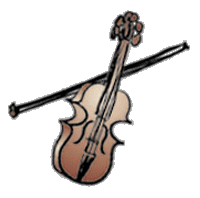


Violinist Chung As Intense as Ever
Allan
Ulrich, Chronicle Music Critic
Wednesday, March 14, 2001
©2001 San Francisco Chronicle
URL: http://www.sfgate.com/cgi-bin/article.cgi?file=/chronicle/archive/2001/03/14/DD222057.DTL
Absent from local concert platforms for seven years, Korean violinist Kyung-Wha Chung returned to Davies Symphony Hall on Monday evening for another of those no-holds-barred recitals for which she achieved distinction in an earlier era. The ageless performer's appearance, a collaboration with Lithuanian pianist Itamar Golan, marked this team's debut for San Francisco Performances; the less-than-capacity house greeted Chung with the affection one might lavish on a relative suddenly returned from the missing.
This was one violinist who always embraced a wide repertoire, and she has not changed. Monday, the menu included one of the supreme tests for fiddlers, Bach's Partita No. 2 in D Minor, BWV 1004, and yet it found room for a couple of sweetmeats by Rachmaninoff, the Two Pieces, Op. 6, rendered with a dollop of sentiment and not an iota of condescension.
Chung acknowledged the century just past with Stravinsky's neoclassical "Duo concertant" and Prokofiev's Sonata No. 1 in F Minor, Op. 80. Encores were a transcription of Debussy's song "Beau soir," "Danse russe" from Stravinsky's "Petrushka" and Dvorak's "Humoresque."
Chung always attacked her material with such unwavering intensity that a performance seemed to convulse her body. That same searing attack yielded a miraculously focused Prokofiev sonata (the more interesting of the two in that format), in which Golan's inflammatory pianism was revealed as a resourceful and imaginative partner.
@sk,1 Burnished technique and refulgent tone like Chung's matter in the Prokofiev. Yet capturing the essence of this composer's astringent lyricism and ironic tone count even more. Monday, the filigree passagework and timbral devices, delivered with an almost turbulent ease, held one spellbound.
Chung's Bach cut through 18th century decorum to achieve a timeless statement of great violin playing. More attention to dynamics and a livelier gait in the Gigue would have been welcome; however, the formidable Chaconne that closes the work fused sonic architecture and an extended musical line. One attended to the unfurling of the 29 variations the way one soaks up a good mystery novel.
A similarly uninhibited approach rather overheated the "Duo concertant." There were hints of slipping pitch here, perhaps a matter of pressing too hard with the bowing arm. Still, if Stravinsky seemed battered a bit, it's refreshing to encounter an artist for whom indifference is anathema. Chung should be a regular visitor here.
E-mail Allan Ulrich at aulrich@sfchronicle.com.
©2001 San Francisco Chronicle